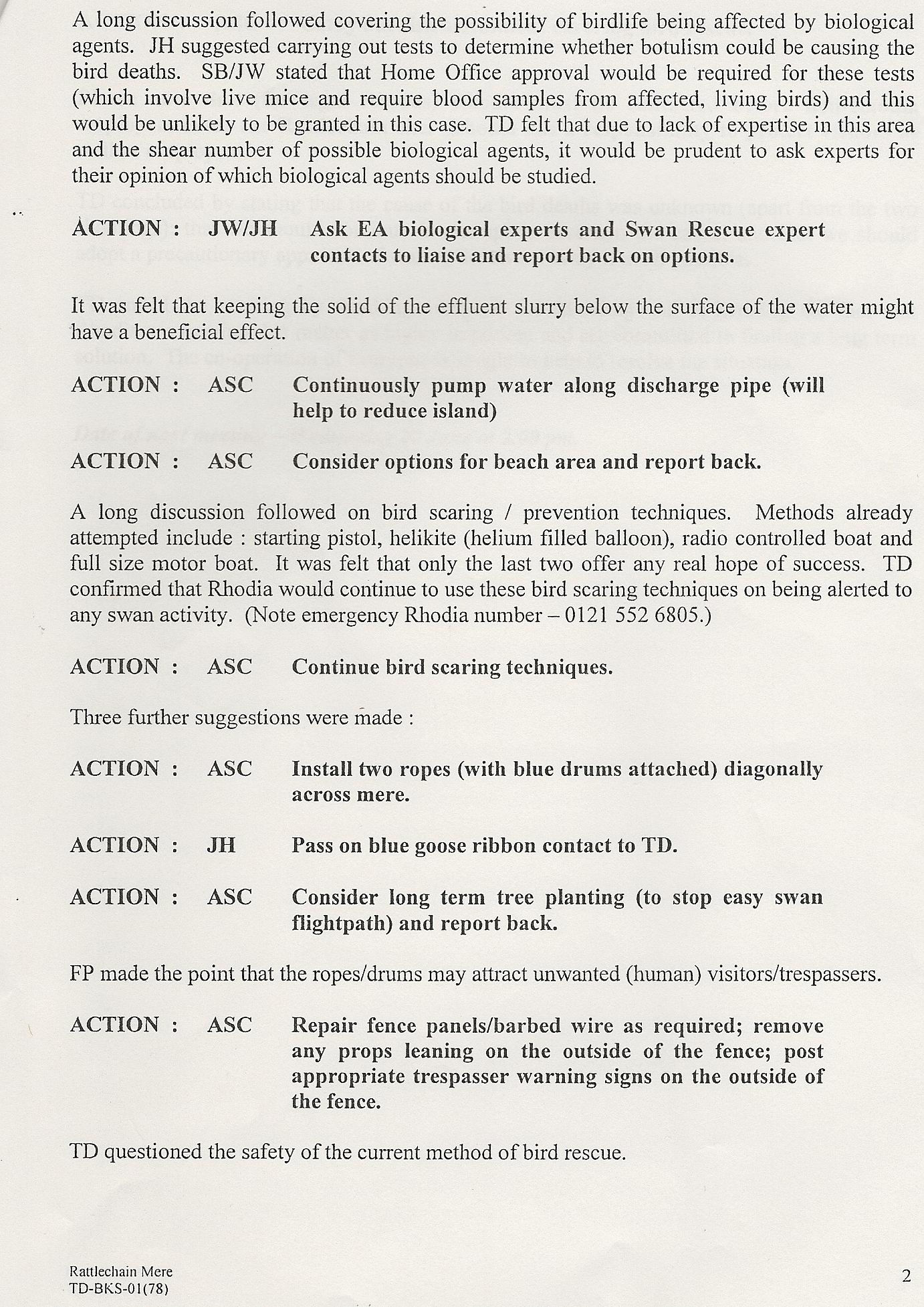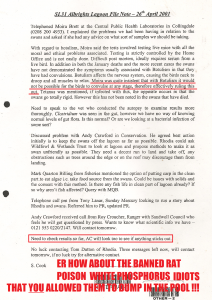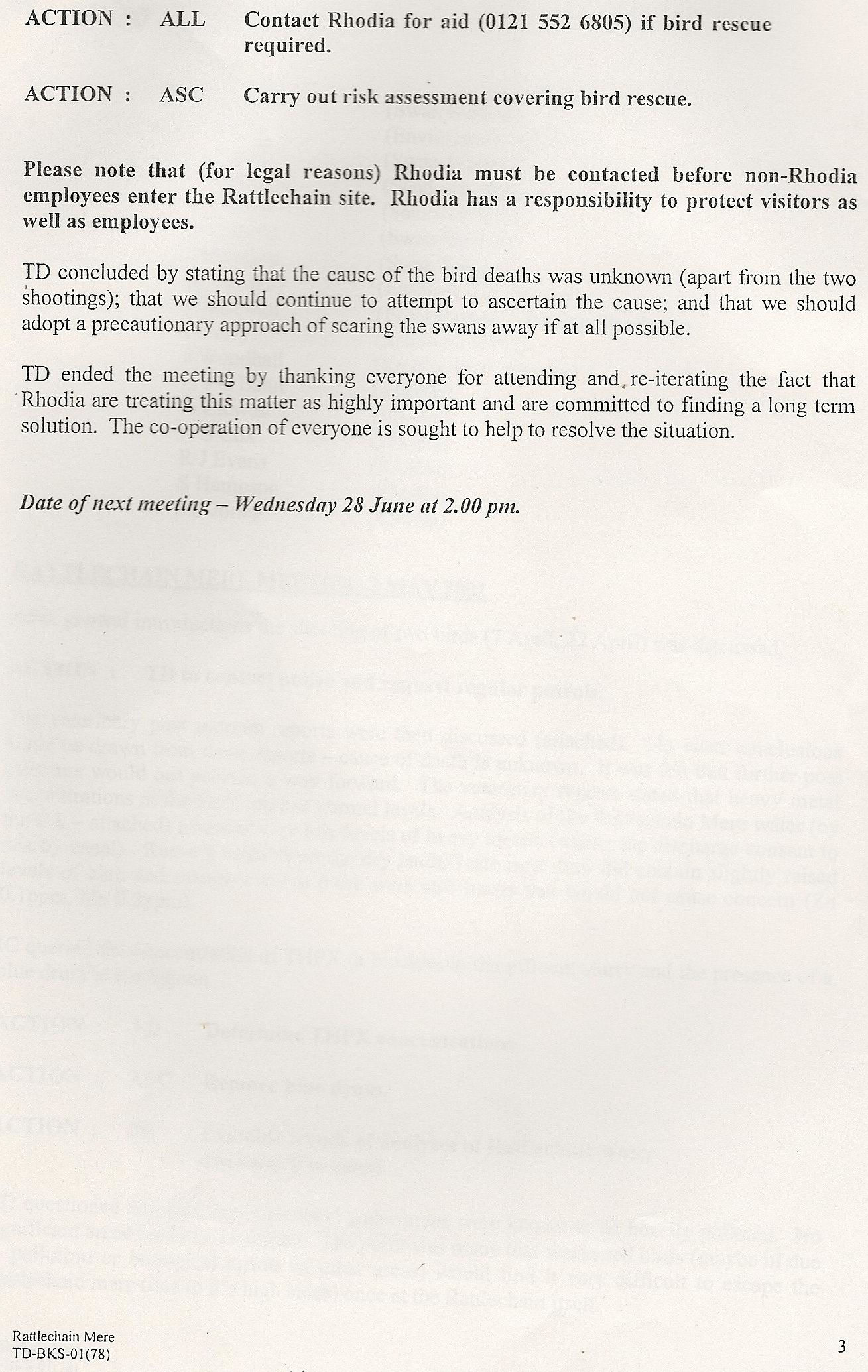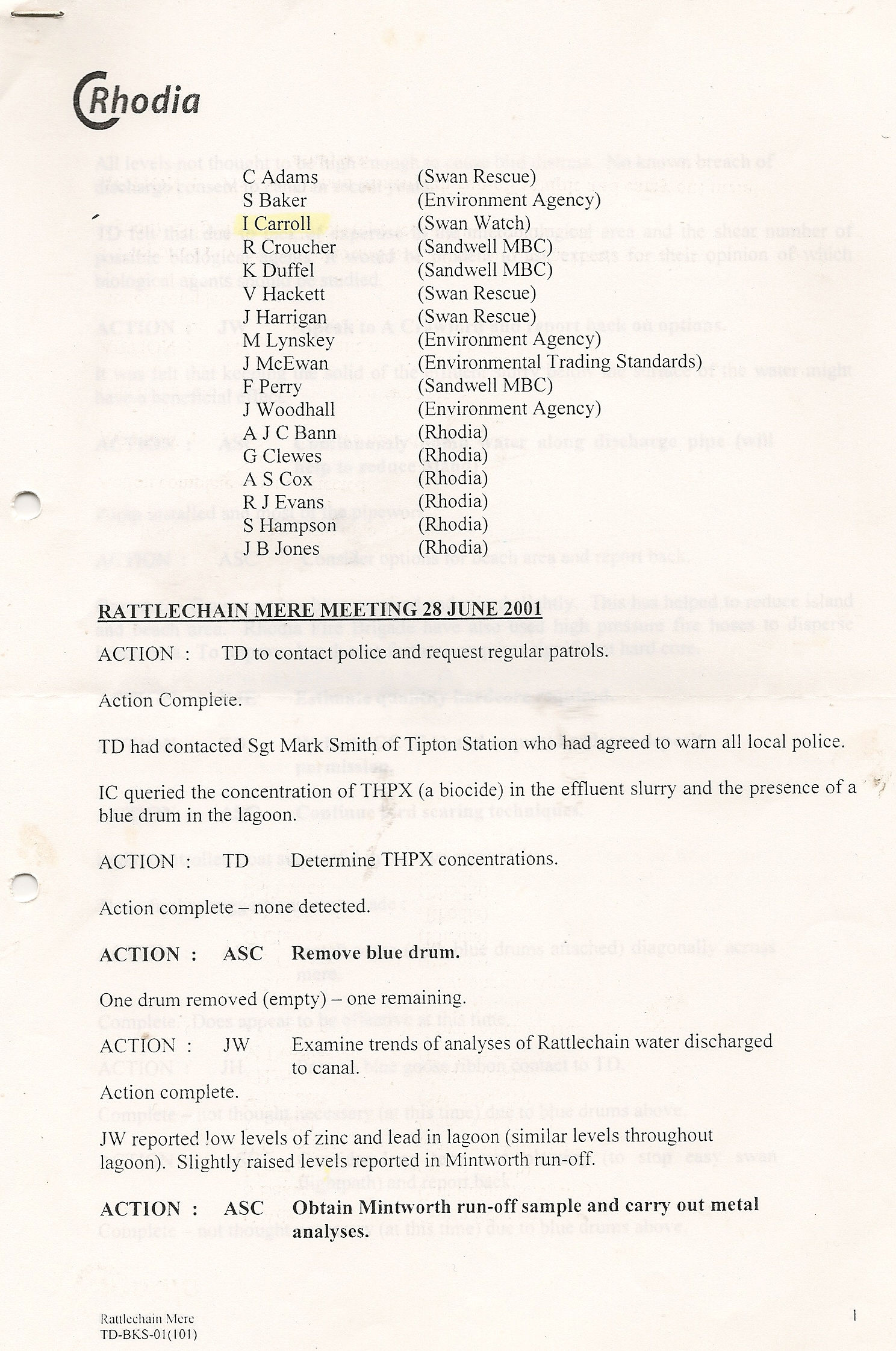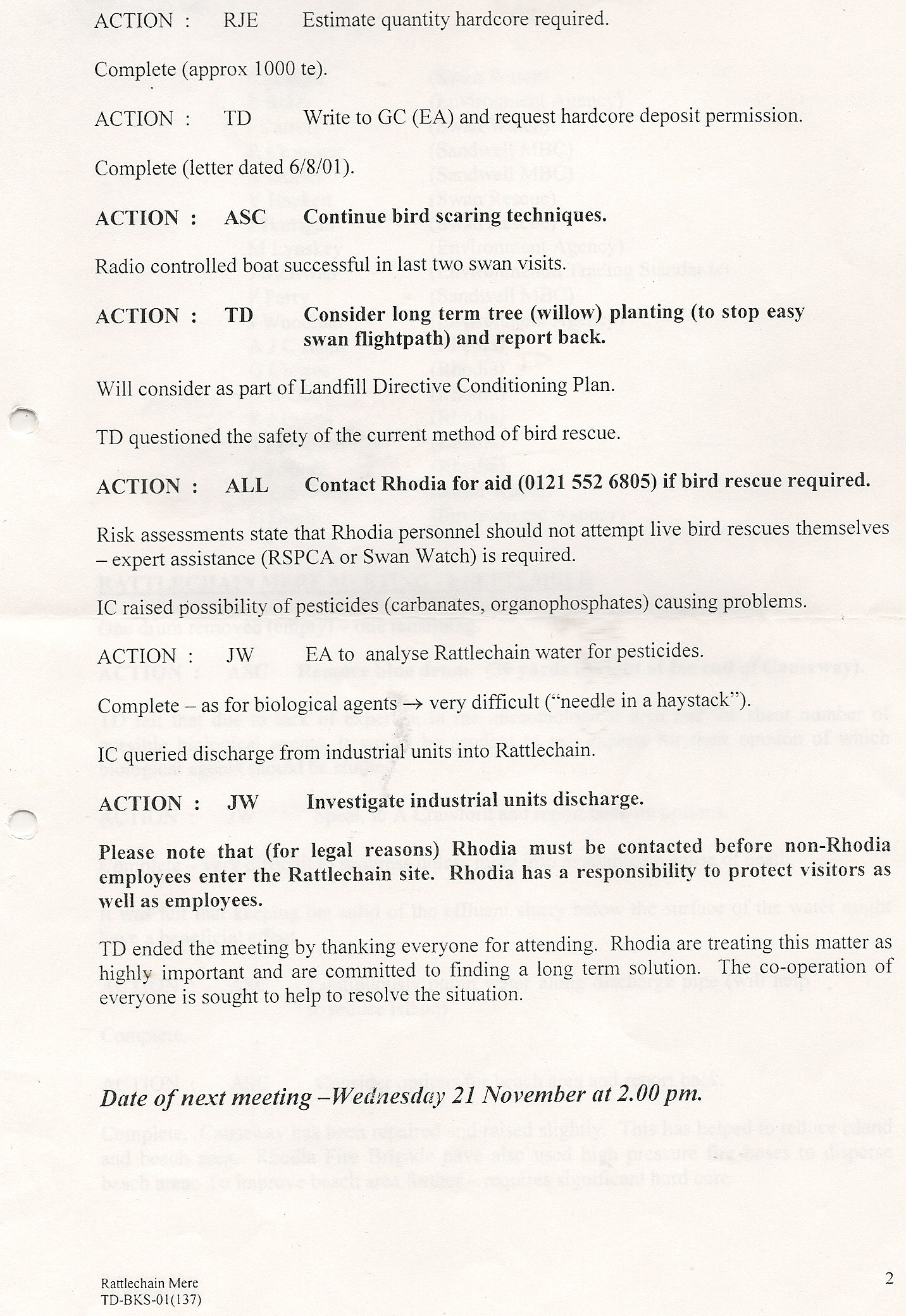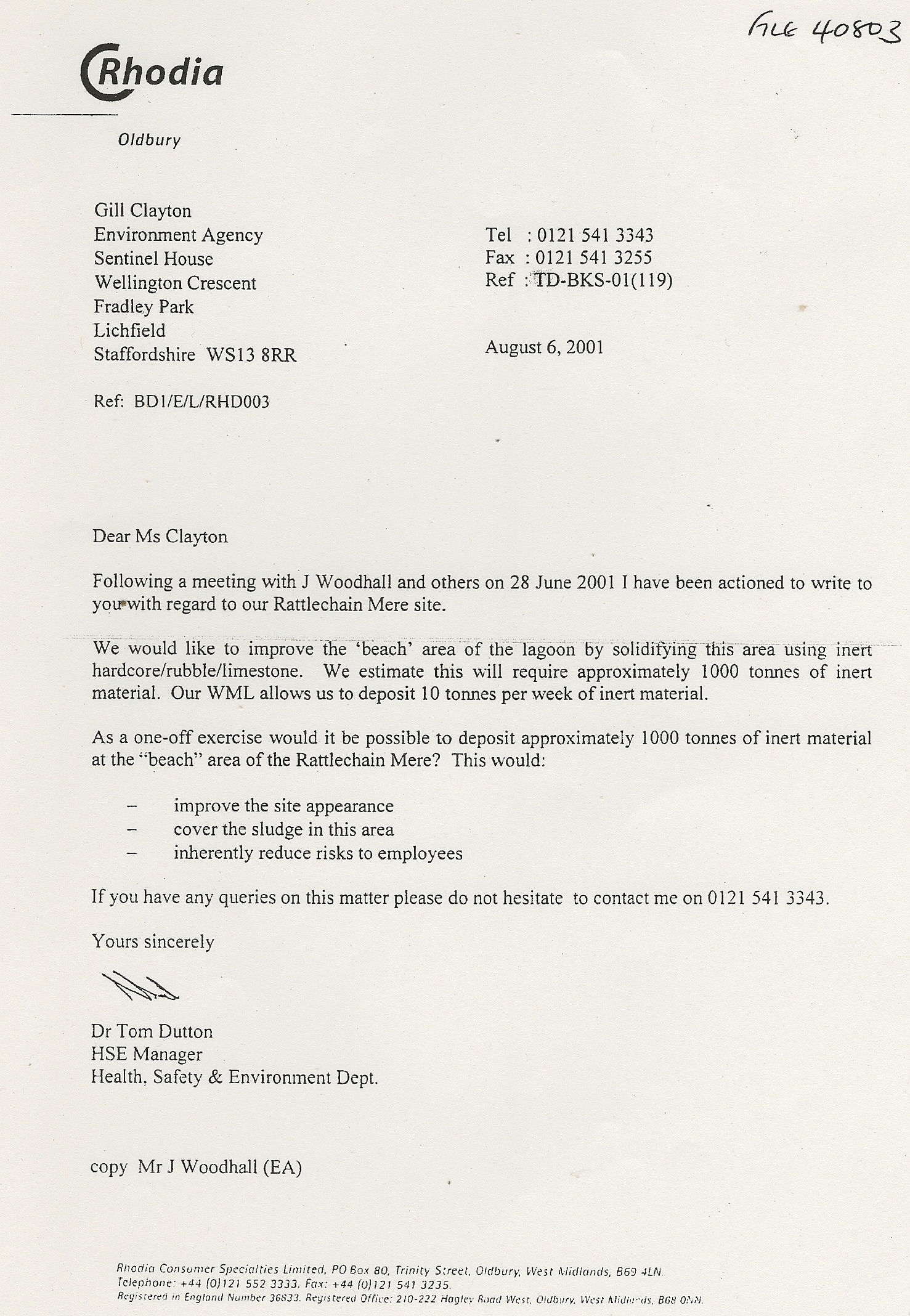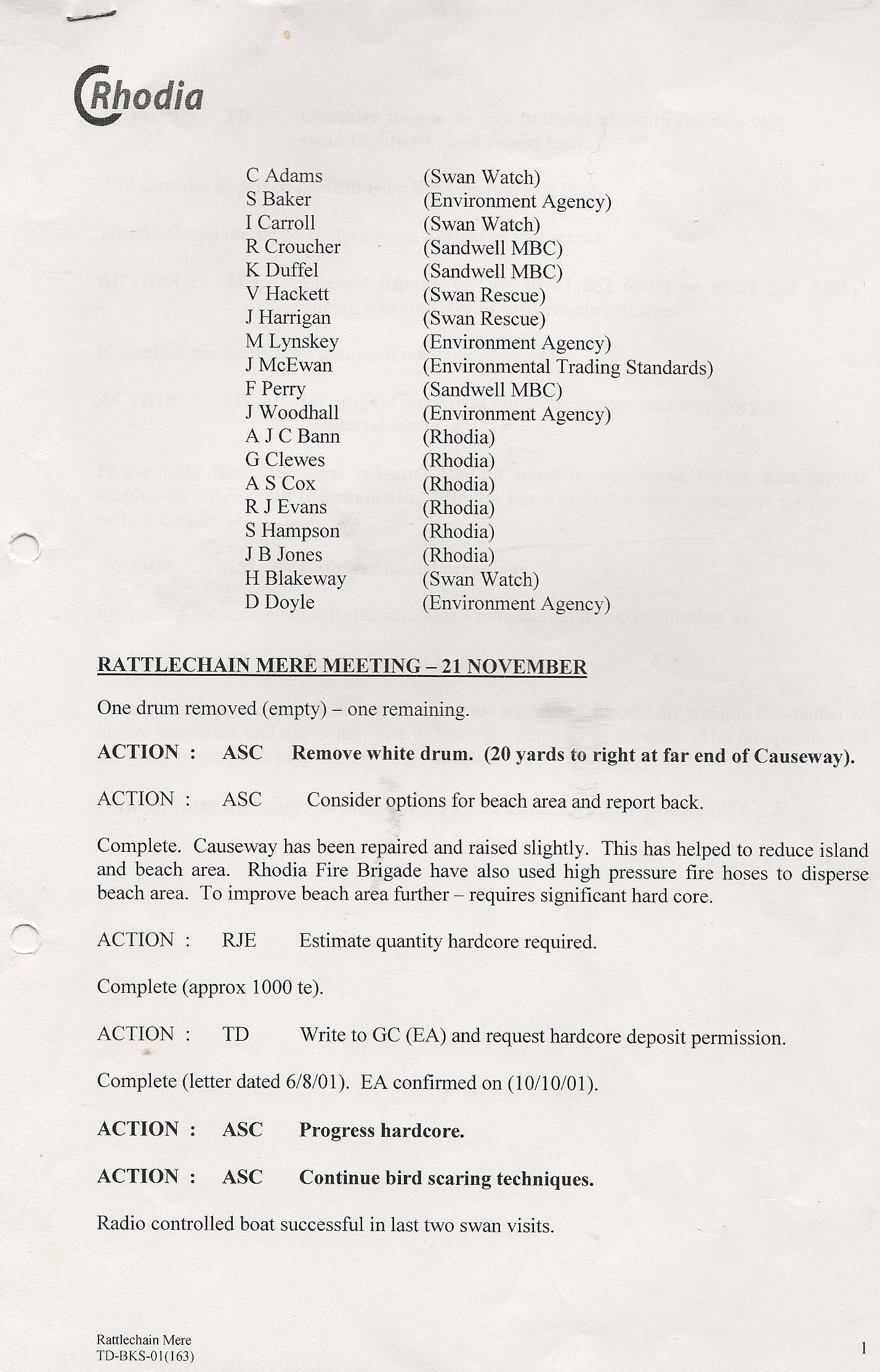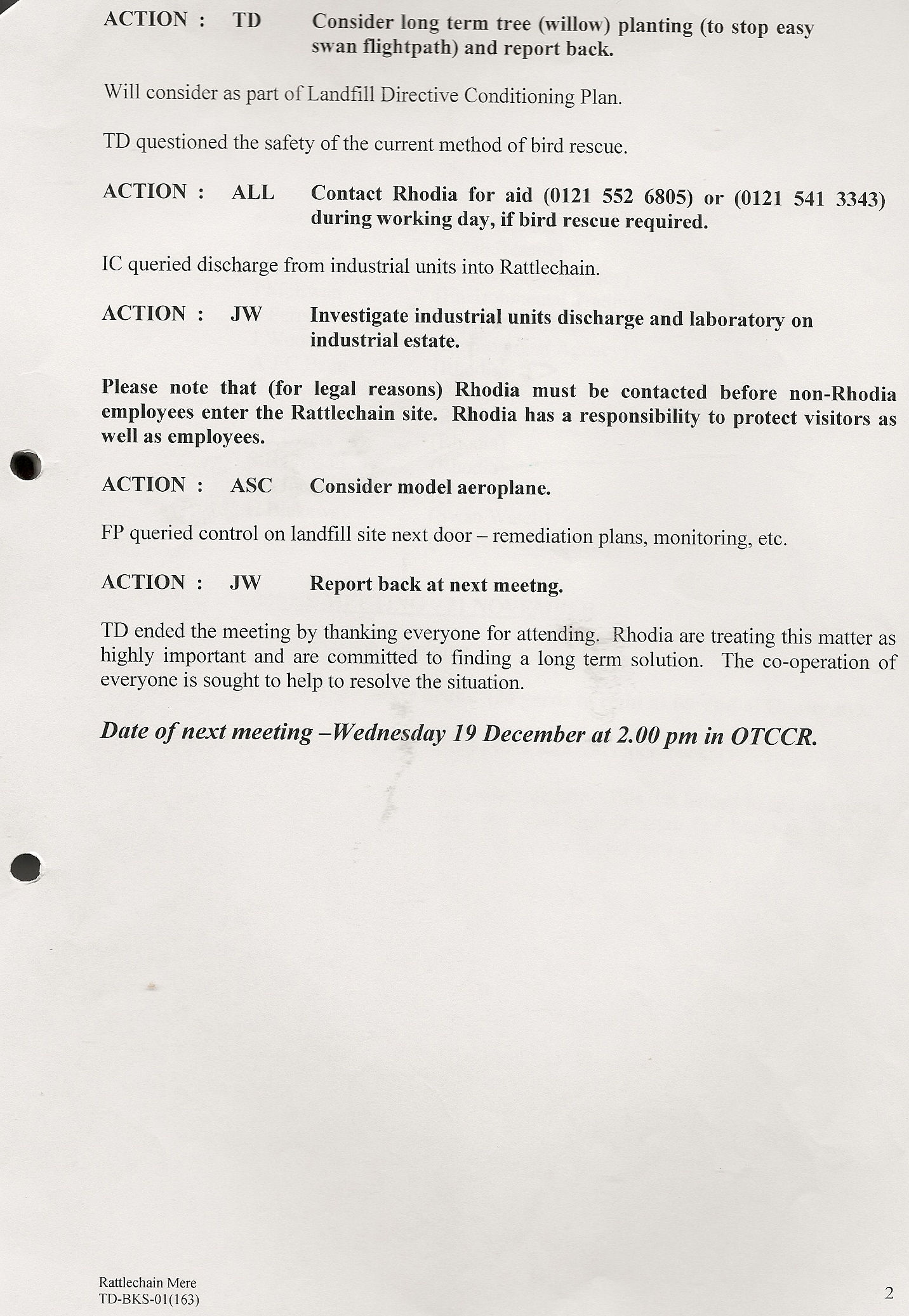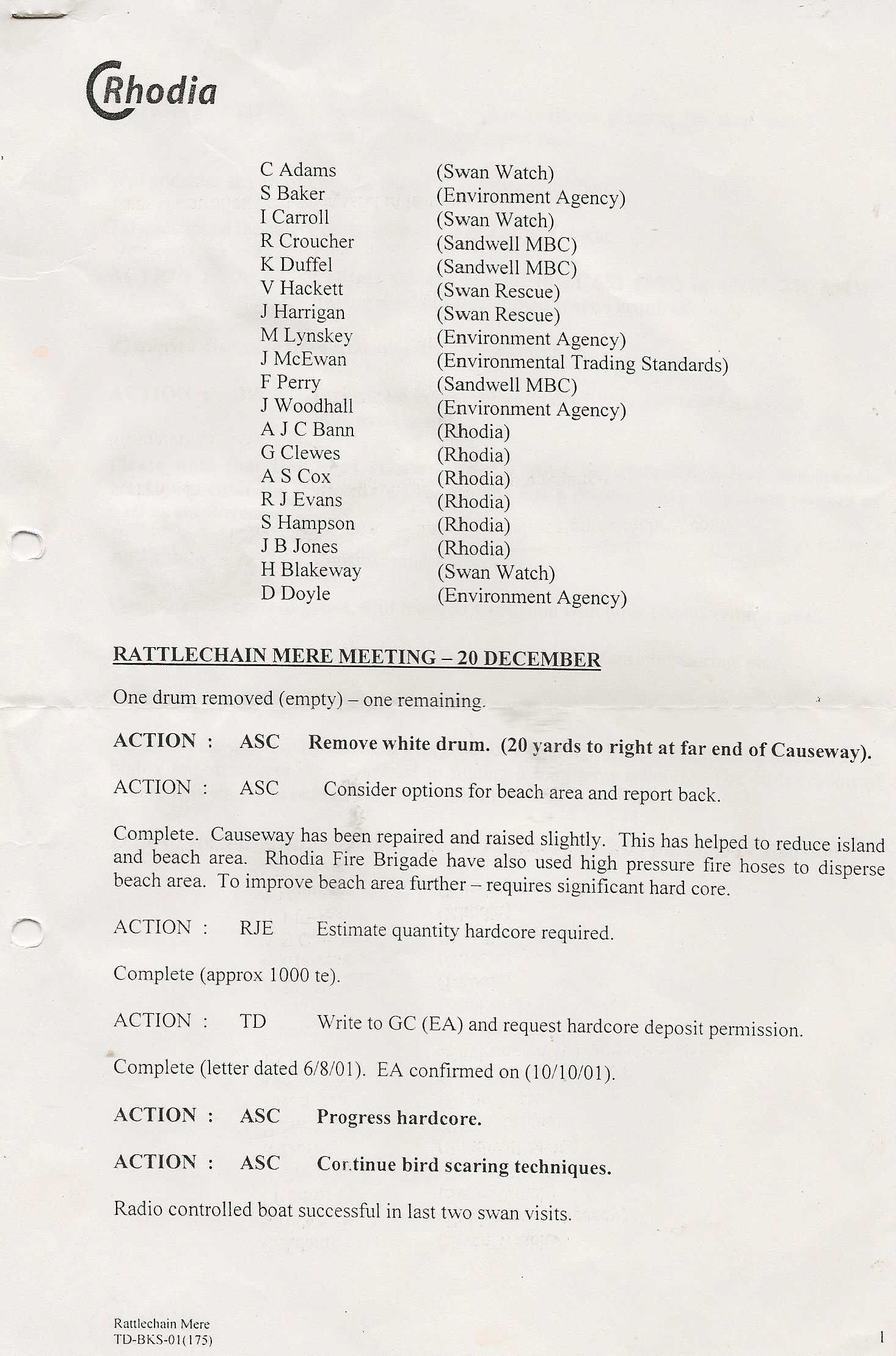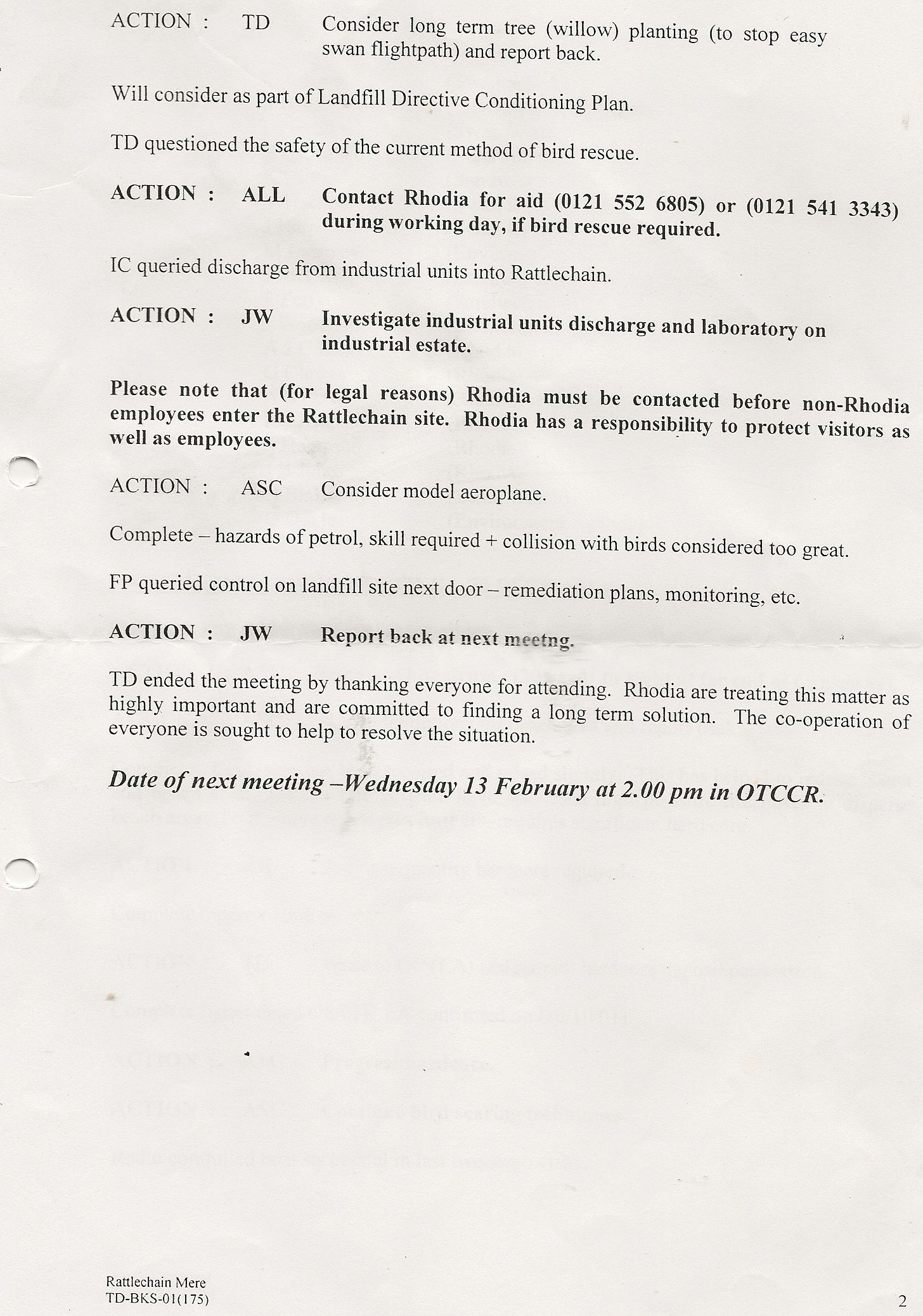MEETINGS OVERVIEW- THE PR STUNT
Bird deaths on site from 1999 were reported to Albright and Wilson as they occurred and later from 2001 periodical meetings, at the suggestion of Rhodia, were held at the Oldbury factory in Trinity Street, and on one occasion at the Rattlechain itself, I believe this was at the time when they were being investigated for a fatal Legionnaires outbreak involving one of their contract tanker drivers, the source of which was traced back to one of their factory cooling towers.
They were chaired by the Health and safety manager, with other staff sometimes in attendance. Also sometimes present were representatives from Sandwell council, the local authority, The Environment Agency and Wychbold Swan Rescue- where many of the dying swans were taken. The minutes were circulated to those on the list.
It is important to note that at no time during these meetings did any representative from Rhodia make clear what was really contained in their toxic waste lagoon, thus THERE WAS NO MENTION OF ANY TOXIC CHEMICALS BEING PRESENT IN THE LAGOON AT THIS TIME ,“HAZARDOUS WASTE”, OR IT’S ACUTE EFFECTS, AND NO INFORMATION WAS FORTHCOMING ABOUT WHAT POTENTIALLY COULD BE KILLING THE BIRDS.
We were led to believe, and they stated in the press that it contained “harmless” calcium phosphate which is used in toothpaste, and also phosphoric acid which is used in coca cola. This was entirely disingenuous, deliberately misleading, and designed only to put us off the scent of white phosphorus and its proven toxic effects.
As an employer handling white phosphorus they were fully aware of its toxic effects on animals and it is completely inconceivable that they did not know or at least suspect the real reason behind the deaths of the birds. Nor at any time when I was invited onto the site to retrieve dead or dying birds was I or other rescuers made aware of the health risks associated with white phosphorus.
It is difficult to believe that these meetings were little more than a public relations exercise, in order for Rhodia to ascertain what we knew or had found out, so that they could devise a counter strategy, whilst at the same time presenting the myth that they actually cared by offering to listen.
It is also shocking that several representatives of both The Environment Agency, regulators of the site were unable to offer any constructive conclusions on the single chemical of concern, or Sandwell Environmental Health officers come to that at these meetings or outside of them.
The minutes of several Rhodia meetings are provided. Below them are some key comments, which with the benefit of our new found knowledge of the site present some difficult questions for Rhodia to answer. In light of our discovery of white phosphorus and related wildfowl mortality on the lagoon we have summarised how this member of the chemical industry manipulated the scenarios to rid itself of blame, by the most deceitful tactics. These will be referenced so that others can see how public relations can operate to distort the truth.
MAY 3RD 2001
3 May 2001
- The two “shot birds” referred to were not conclusively found to have been killed after having been shot. A swan on the site had an air gun pellet in its neck, but was found dead on the smaller lagoon. A canada goose was found with “a trauma wound” which could have been caused by post mortem predation. THUS THE SCENE IS SET FOR TRYING TO DISTRACT ATTENTION AWAY FROM THE CONTENTS OF THE LAGOON SEDIMENT.
- The first thing to note is Rhodia’s attempt to call the site “Rattlechain Mere” instead of “tip”- the license name as it appears, or “lagoon” as in “phosphorus lagoon.” The noun “Mere” lends a poetic connotation, yet ironically the adjective meaning “pure” or “nothing more than” is anything but the description that can be applied to this toxic hazardous waste dump.
- “It was felt that further post mortems would not provide a way forward”. This comment is correct in that gross post mortems would not be likely to show any sign of white phosphorus poisoning. However if the information concerning white phosphorus being present in the sediment had been forthcoming from Rhodia then this would have provided “a way forward” .
- There is clearly an attempt to lay the red herring of “heavy metals” being responsible for the bird deaths. Not only were these not found but Rhodia are keen to try to state that the levels of heavy metals in the lagoon WATER were also very low levels. NOTE THE ATTEMPT TO DRAW ATTENTION TO THE WATER, AND THEREFORE TO DISTRACT AWAY ATTENTION FROM THE TOXIC SEDIMENT UNDERNEATH IT THAT THEY KNOW IS SUCH.
- I innocently queried “what is a biocide used for?” given that Rhodia manufactured several of them commercially.
- Not only do they deceive about the water but they then go on to mention the Mintworth owned site, and then “TD questioned if any other known local water areas were known to be heavily polluted.”
Absolutely priceless comment, this one! THE ANSWER TO THIS QUESTION IS “CERTAINLY NONE IN THE WEST MIDLANDS AREA, OR PROBABLY THE COUNTRY AS THE SITE WHICH YOU CLAIM TO BE HEALTH AND SAFETY MANAGER OF!”
- Thus Rhodia attempt from the outset to deceive about the waste that they know is in the lake, the possibility of this waste having poisoned the birds and the suggestion that another site or cause is to blame. DECEIT AND LIES.
- “a long discussion followed covering the possibility of birdlife being affected by biological agents… TD felt that due to lack of expertise in this area and shear number of possible biological agents, it would be prudent to ask experts for their opinion of which biological agents should be studied.”
Tom Dutton is Health and safety manager of one of the world’s leading suppliers of phosphorus derivatives; white phosphorus being a chemical that has been used at the Oldbury factory for over 150 years, where fatalities had occurred and where workers had been burned and contracted phossy jaw ( Albright and Wilson) and also Rhodia provide employees with free dental treatment because of this).
Perhaps some openess about the single one biological agent in question, namely white phosphorus, then we would have been able to present this information to the VLA at the time for future post mortems, as well as giving us information about taking precautions against this highly toxic “biological agent”.
- “it was felt that keeping the solid of the effluent slurry below the surface of the water might have a beneficial effect”.
This was a requirement of the waste management permit. The waste should not have been above the surface of the water, a clear license breach.
Hiding the sediment under water and pretending that this “biological agent” is no longer there appears to be the solution to all this companies problems. Put the case that at this time Rhodia knowingly make reference to what they know or must strongly suspect to be the cause of bird mortality on pool, whilst not naming it directly. Put forward the bluff and invite “opinion” to see if anyone else can make the link between the white phosphorus and toxicity whilst trying to make our non expert task of identifying the cause appear impossible, “shear number”. We only needed to know the biological effects on people and animals of one chemical, and at this time we were not informed of them BY ANY EMPLOYEE OF RHODIA, AND IT APPEARS THE “PROFESSIONALS” IN THE EA WERE CLUELESS. As evidenced in this file note which preceded the meeting. Note Botulism was quickly ruled out, yet at this meeting the EA officers did not state that they had already received advice that this was a red herring- WHY?
Are we too harsh here to suggest that deciding to collude that it was something “natural” that could not be proven was an easier option to suit the company’s embarrasment as well as being a human health risk and a pollution control issue to the regulator if the real cause was established?
- The “bird scaring techniques” should be noted. Ropes and barrels WERE NOT put across the lagoon at OUR suggestion.
- “Rhodia has a responsibility to protect visitors as well as employees”.
So why don’t they inform visitors about what hazardous chemicals they suspect they may have come into contact with, after inviting them onto the site?
- “The co-operation of everyone is sought to help resolve the situation“
It would have been nice if Rhodia had co-operated by giving us a list of toxic materials that its technically competent staff on the waste management licence and present at the meetings knew were present in the waste sediments at this time.
28th June 2001
- “IC queried the concentration of THPX( a biocide) in the effluent slurry and the presence of a blue drum in the lagoon.”. I queried the products they made after looking them up on the internet and asked about Tolcide and what a “biocide” was. Why would he have needed to have done this when there is no mention of allowing this chemical into the pool under licence SL31 in the first place? I never did get an answer to my question.
Meeting 28th June 2001 follows the action point “Action complete- none detected”.
Exactly how were they able to determine the quantity of this chemical in hundreds of thousands of tonnes of waste in this pool? Who carried out this test and was it independently verified? It certainly was not the Environment Agency.
- The drum I referred to was a rusty drum that was only removed a couple of years ago where I pointed it out to two Rhodia employees who removed it. Conclusion- they don’t know what has been dumped in the pool since 1948, and are even less in a position to be able to qualify concentrations.
- It is incredible that the Environment agency were taken in by the water testing distraction, and that their staff could not offer any suggestions concerning the toxicity of white phosphorus in the solid sediments. They are the regulators of the site licence which mentions the substance after all.
- “the shear number of possible biological agents, it would be prudent to ask experts of their opinion of what biological agents should be studied.”
As Albright and Wilson and Rhodia the leading supplier of phosphorus derivatives and a known “biological agent” perhaps white phosphorus should have been studied. There was no “shear number” ;just one- a disgraceful attempt to widen the scope out to illicit a shoal of red herrings.
- “Rhodia fire brigade have also used high pressure fire hoses to disperse beach area.”
This is blatant knowledge of the issue of concern though they do not reveal it here. The beach area was where AW bombs were disposed of, it was where the fire in 1989 had occurred when a tanker driver had emptied out the waste onto the ground and the white phosphorus in the stream had caught fire. It was also the area that the Environment agency had repeatedly told them in inspection reports to clear up, and it was also the area where they breached the licence by not keeping the waste below the water level. In essence they merely wanted to spread the contamination out further affield and below the water out of sight.
- “to improve beach area further -requires significant hardcore.”
And then bury any excess waste by dumping solids over the top of it in the hope that it would put it out of reach of the birds. Hmmm sounds very much like what they are currently proposing.
- “IC RAISED PROSPECT OF PESTICIDES (CARBONATES,ORGANOPHOSPHATES) CAUSING PROBLEMS.”
A dramatically ironic possibility as my psychic vibes were not far out. It wasn’t the poisons that are produced from phosphorus however but the elemental form itself. As it is Albright and Wilson made both. Another window for Rhodia to come clean, and another example of how they did not. Once again the EA look to the water for answers, which Rhodia know would provide none.
6th September 2001
- ACTION- JW speak to A Crawford and report back on options
Very difficult to progress unless more info available on cause of death.
Here we have an EA pollution prevention control officer and the EA conservation officer, reliant on gathering information from the post mortems, which gleaned none, basically because no-one in the EA could tell those carrying out the post mortems what they should have been looking for as the most obvious “cause” of death- TOXIC WHITE PHOSPHORUS IN THE SEDIMENT.
Rhodia require 1000 tonnes of “inert” hardcore to “improve” the beach area.” That’s quite a bit, but was it from old demolished waste buildings that were at Trinity Street- “kill two birds with one stone”- or several more?
“IC RAISED PROSPECT OF PESTICIDES (CARBONATES,ORGANOPHOSPHATES) CAUSING PROBLEMS.”
Complete- as for biological agents- very difficult (“needle in a haystack”)
Very easy really, white phosphorus known to be in the sediment by both Rhodia and the EA, several textbooks, and the internet was well established in 2001. We do agree however that it is very easy for one prick to kill a bird.
21st November 2001
20th December 2001
Meetings declined in intervening years though the bird deaths did not, with little or nothing happening in terms of new information coming to light, or any offered by Rhodia Works management.
In March 2008 a meeting was called after a news item on BBC Midlands Today involving myself and video of a dying swan- the first to be recorded on film.“yellow phosphorus” was mentioned for the first time concerning the waste management license details though once again, Rhodia minuted these in a misleading form (as a percentage of the total waste and not the overall weight value in white phosphorus present). At this meeting it was also stated that Rhodia had no records before 1974 of what Albright and Wilson had put in the lake but “they thought they knew” what had gone in here.
The Eagle River Flats studies were presented to Tom Dutton at the next meeting. The URS “bird deterrence” report was then commissioned by Rhodia but still made no mention of white phosphorus and its proven biological effects, except in the references.
I have asked on several occasions questions which I put in writing to Rhodia to be answered in writing but they have declined to do so.
At one meeting I was called aside and told:”The lawyers have advised me not to answer them as it could implicate the company.”
At one meeting attended by some local residents the question was asked “Is white phosphorus harmful?”
“It’s alright as long as you don’t swallow it” was Tom Dutton’s reply to which one resident said “what kind of $h£t is that?”
Our thoughts exactly. Unfortunately many wildfowl have swallowed this toxic chemical as evidenced in the Harlan Laboratory reports paid for by Rhodia. If this one source of information had been forthcoming back in 2001, when the opportunity existed, then perhaps the antipathy that we have towards this deceitful company could have been avoided. As could many deaths of subsequent birds.
We leave people to draw their own conclusions but having swallowed their lies once that this pool was “safe”, we won’t be making the same mistake again.


